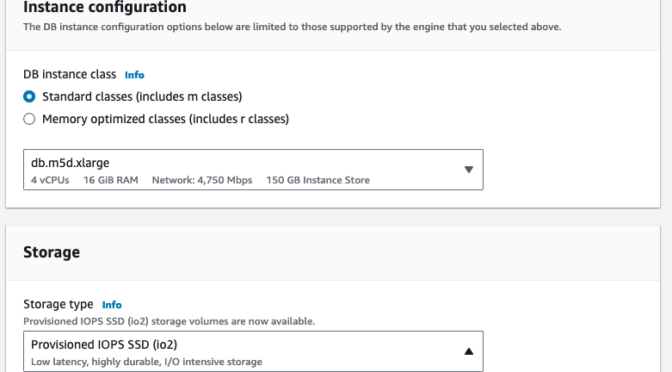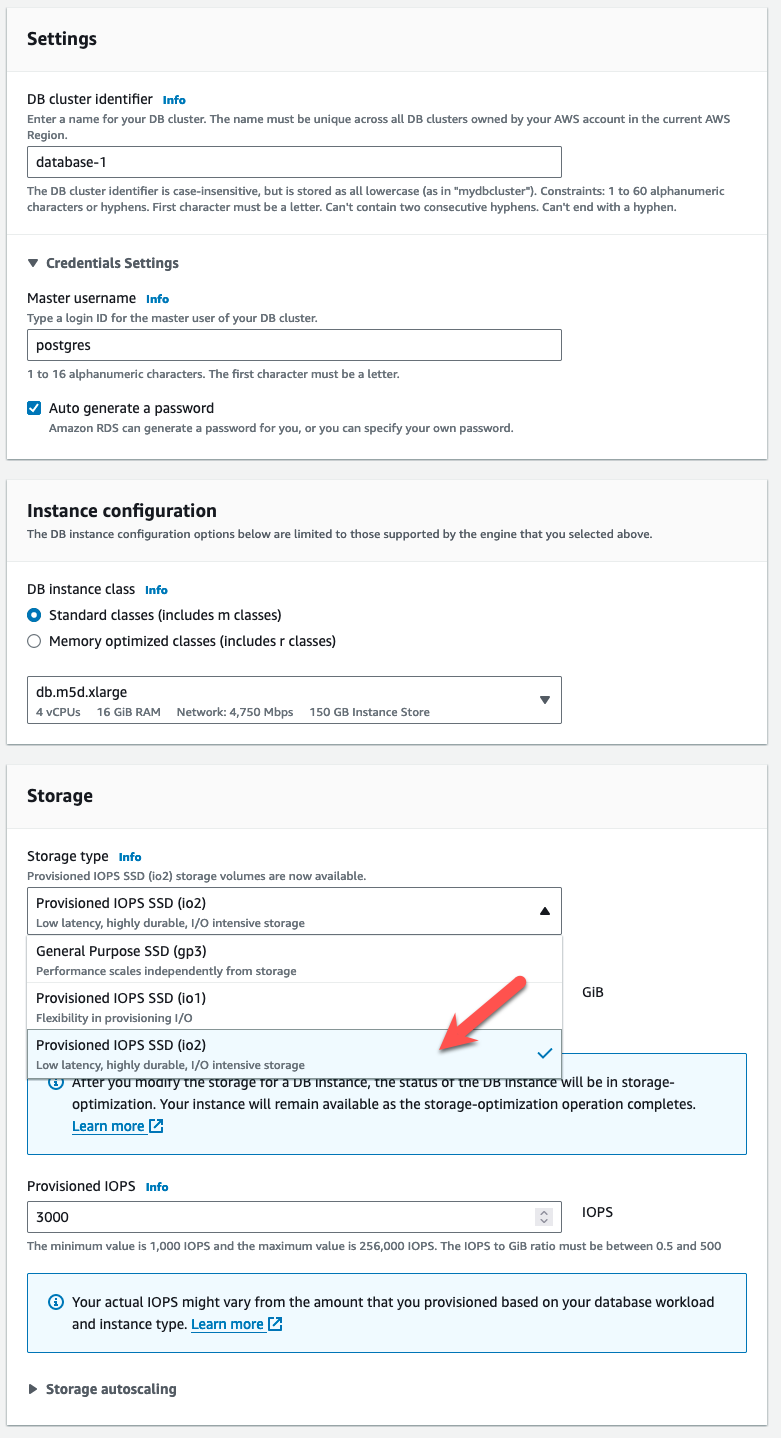[This is a Guest Diary by Josh Lockwood, an ISC intern as part of the SANS.edu Bachelor's Degree in Applied Cybersecurity (BACS) program [1].
Monthly Archives: March 2024
Amazon RDS now supports io2 Block Express volumes for mission-critical database workloads
Today, I am pleased to announce the availability of Provisioned IOPS (PIOPS) io2 Block Express storage volumes for all database engines in Amazon Relational Database Service (Amazon RDS). Amazon RDS provides you the flexibility to choose between different storage types depending on the performance requirements of your database workload. io2 Block Express volumes are designed for critical database workloads that require high performance and high throughput at low latency.
Lower latency and higher availability for I/O intensive workloads
With io2 Block Express volumes, your database workloads will benefit from consistent sub-millisecond latency, enhanced durability to 99.999 percent over io1 volumes, and drive 20x more IOPS from provisioned storage (up to 1,000 IOPS per GB) at the same price as io1. You can upgrade from io1 volumes to io2 Block Express volumes without any downtime, significantly improving the performance and reliability of your applications without increasing storage cost.
“We migrated all of our primary Amazon RDS instances to io2 Block Express within 2 weeks,” said Samir Goel, Director of Engineering at Figma, a leading platform for teams that design and build digital products. “Io2 Block Express has had a profound impact on the availability of the database layer at Figma. We have deeply appreciated the consistency of performance with io2 Block Express — in our observations, the latency variability has been under 0.1ms.”
io2 Block Express volumes support up to 64 TiB of storage, up to 256,000 Provisioned IOPS, and a maximum throughput of 4,000 MiB/s. The throughput of io2 Block Express volumes varies based on the amount of provisioned IOPS and volume storage size. Here is the range for each database engine and storage size:
| Database engine | Storage size | Provisioned IOPS | Maximum throughput |
| Db2, MariaDB, MySQL, and PostgreSQL | Between 100 and 65,536 GiB | 1,000–256,000 IOPS | 4,000 MiB/s |
| Oracle | Between 100 and 199 GiB | 1,000–199,000 IOPS | 4,000 MiB/s |
| Oracle | Between 200 and 65,536 GiB | 1,000–256,000 IOPS | 4,000 MiB/s |
| SQL Server | Between 20 and 16,384 GiB | 1,000–64,000 IOPS | 4,000 MiB/s |
Getting started with io2 Block Express in Amazon RDS
You can use the Amazon RDS console to create a new RDS instance configured with an io2 Block Express volume or modify an existing instance with io1, gp2, or gp3 volumes.
Here’s how you would create an Amazon RDS for PostgreSQL instance with io2 Block Express volume.
Start with the basic information such as engine and version. Then, choose Provisioned IOPS SDD (io2) from the Storage type options:
Use the following AWS CLI command to create a new RDS instance with io2 Block Express volume:
aws rds create-db-instance --storage-type io2 --db-instance-identifier new-db-instance --db-instance-class db.t4g.large --engine mysql --master-username masteruser --master-user-password <enter password> --allocated-storage 400 --iops 3000Similarly, to modify an existing RDS instance to use io2 Block Express volume:
aws rds modify-db-instance --db-instance-identifier existing-db-instance --storage-type io2 --allocated-storage 500 --iops 3000 --apply-immediatelyThings to know
- io2 Block Express volumes are available on all RDS databases using AWS Nitro System instances.
- io2 Block Express volumes support an IOPS to allocated storage ratio of 1000:1. As an example, With an RDS for PostgreSQL instance, the maximum IOPS can be provisioned with volumes 256 GiB and larger (1,000 IOPS × 256 GiB = 256,000 IOPS).
- For DB instances not based on the AWS Nitro System, the ratio of IOPS to allocated storage is 500:1. In this case, maximum IOPS can be achieved with 512 GiB volume (500 IOPS x 512 GiB = 256,000 IOPS).
Available now
Amazon RDS io2 Block Express storage volumes are supported for all RDS database engines and are available in US East (Ohio, N. Virginia), US West (N. California, Oregon), Asia Pacific (Hong Kong, Mumbai, Osaka, Seoul, Singapore, Sydney, Tokyo), Canada (Central), Europe (Frankfurt, Ireland, London, Stockholm), and Middle East (Bahrain) Regions.
In terms of pricing and billing, io1 volumes and io2 Block Express storage volumes are billed at the same rate. For more information, see the Amazon RDS pricing page.
Learn more by reading about Provisioned IOPS SSD storage in the Amazon RDS User Guide.
— Abhishek
Scanning and abusing the QUIC protocol, (Wed, Mar 6th)
The QUIC protocol has slowly (pun intended) crawled into our browsers and many other protocols. Last week, at BSides Zagreb I presented some research I did about applications using (and abusing) this protocol, so it made sense to put this into one diary.
Apple Releases iOS/iPadOS Updates with Zero Day Fixes., (Tue, Mar 5th)
Apple today released iOS 17.4 as well as iOS 16.7.6 (and the respective iPadOS versions). These updates fix a total of four vulnerabilities. Two of the vulnerabilities are already being exploited. CVE-2024-23225 is a privilege escalation issue and only affects iOS 17 as well as iOS 16. The second already exploited vulnerability, CVE-2024-23296, only affects iOS 17.
We rated the exploited vulnerabilities as "important", not "critical". They appear to only allow for privilege escalation.
| iOS 17.4 and iPadOS 17.4 | iOS 16.7.6 and iPadOS 16.7.6 |
|---|---|
| CVE-2024-23243 [important] Accessibility A privacy issue was addressed with improved private data redaction for log entries. An app may be able to read sensitive location information |
|
| x | |
| CVE-2024-23225 [moderate] *** EXPLOITED *** Kernel A memory corruption issue was addressed with improved validation. An attacker with arbitrary kernel read and write capability may be able to bypass kernel memory protections. Apple is aware of a report that this issue may have been exploited. |
|
| x | x |
| CVE-2024-23296 [moderate] *** EXPLOITED *** RTKit A memory corruption issue was addressed with improved validation. An attacker with arbitrary kernel read and write capability may be able to bypass kernel memory protections. Apple is aware of a report that this issue may have been exploited. |
|
| x | |
| CVE-2024-23256 [moderate] Safari Private Browsing A logic issue was addressed with improved state management. A user's locked tabs may be briefly visible while switching tab groups when Locked Private Browsing is enabled |
|
| x | |
—
Johannes B. Ullrich, Ph.D. , Dean of Research, SANS.edu
Twitter|
(c) SANS Internet Storm Center. https://isc.sans.edu Creative Commons Attribution-Noncommercial 3.0 United States License.
Why Your Firewall Will Kill You, (Tue, Mar 5th)
The last few years have been great for attackers exploiting basic web application vulnerabilities. Usually, home and small business products from companies like Linksys, D-Link, and Ubiquity are known to be favorite targets. But over the last couple of years, enterprise products from companies like Ivanti, Fortigate, Sonicwall, and Citrix (among others) have become easy to exploit targets. The high value of the networks protected by these "solutions" has made them favorites for ransomware attackers.
Free data transfer out to internet when moving out of AWS
You told us one of the primary reasons to adopt Amazon Web Services (AWS) is the broad choice of services we offer, enabling you to innovate, build, deploy, and monitor your workloads. AWS has continuously expanded its services to support virtually any cloud workload. It now offers over 200 fully featured services for compute, storage, databases, networking, analytics, machine learning (ML) and artificial intelligence (AI), and many more. For example, Amazon Elastic Compute Cloud (Amazon EC2) offers over 750 generally available instances—more than any other major cloud provider—and you can choose from numerous relational, analytics, key-value, document, or graph databases.
We believe this choice must include the one to migrate your data to another cloud provider or on-premises. That’s why, starting today, we’re waiving data transfer out to the internet (DTO) charges when you want to move outside of AWS.
Over 90 percent of our customers already incur no data transfer expenses out of AWS because we provide 100 gigabytes per month free from AWS Regions to the internet. This includes traffic from Amazon EC2, Amazon Simple Storage Service (Amazon S3), Application Load Balancer, among others. In addition, we offer one terabyte of free data transfer out of Amazon CloudFront every month.
If you need more than 100 gigabytes of data transfer out per month while transitioning, you can contact AWS Support to ask for free DTO rates for the additional data. It’s necessary to go through support because you make hundreds of millions of data transfers each day, and we generally do not know if the data transferred out to the internet is a normal part of your business or a one-time transfer as part of a switch to another cloud provider or on premises.
We will review requests at the AWS account level. Once approved, we will provide credits for the data being migrated. We don’t require you to close your account or change your relationship with AWS in any way. You’re welcome to come back at any time. We will, of course, apply additional scrutiny if the same AWS account applies multiple times for free DTO.
We believe in customer choice, including the choice to move your data out of AWS. The waiver on data transfer out to the internet charges also follows the direction set by the European Data Act and is available to all AWS customers around the world and from any AWS Region.
Freedom of choice is not limited to data transfer rates. AWS also supports Fair Software Licensing Principles, which make it easy to use software with other IT providers of your choice. You can read this blog post for more details.
You can check the FAQ for more information, or you can contact AWS Customer Support to request credits for DTO while switching.
But I sincerely hope you will not.
Anthropic’s Claude 3 Sonnet foundation model is now available in Amazon Bedrock
In September 2023, we announced a strategic collaboration with Anthropic that brought together their respective technology and expertise in safer generative artificial intelligence (AI), to accelerate the development of Anthropic’s Claude foundation models (FMs) and make them widely accessible to AWS customers. You can get early access to unique features of Anthropic’s Claude model in Amazon Bedrock to reimagine user experiences, reinvent your businesses, and accelerate your generative AI journeys.
In November 2023, Amazon Bedrock provided access to Anthropic’s Claude 2.1, which delivers key capabilities to build generative AI for enterprises. Claude 2.1 includes a 200,000 token context window, reduced rates of hallucination, improved accuracy over long documents, system prompts, and a beta tool use feature for function calling and workflow orchestration.
Today, Anthropic announced Claude 3, a new family of state-of-the-art AI models that allows customers to choose the exact combination of intelligence, speed, and cost that suits their business needs. The three models in the family are Claude 3 Haiku, the fastest and most compact model for near-instant responsiveness, Claude 3 Sonnet, the ideal balanced model between skills and speed, and Claude 3 Opus, a most intelligent offering for the top-level performance on highly complex tasks.
We’re also announcing the availability of Anthropic’s Claude 3 Sonnet today in Amazon Bedrock, with Claude 3 Opus and Claude 3 Haiku coming soon. For the vast majority of workloads, Claude 3 Sonnet model is two times faster than Claude 2 and Claude 2.1, with increased steerability, and new image-to-text vision capabilities.
With Claude 3 Sonnet’s availability in Amazon Bedrock, you can build cost-effective generative AI applications for enterprises that need intelligence, reliability, and speed. You can now use Anthropic’s latest model, Claude 3 Sonnet, in the Amazon Bedrock console.
Introduction of Anthropic’s Claude 3 Sonnet
Here are some key highlights about the new Claude 3 Sonnet model in Amazon Bedrock:
2x faster speed – Claude 3 has made significant gains in speed. For the vast majority of workloads, it is two times faster with the same level of intelligence as Anthropic’s most performant models, Claude 2 and Claude 2.1. This combination of speed and skill makes Claude 3 Sonnet the clear choice for tasks that require intelligent tasks demanding rapid responses, like knowledge retrieval or sales automation. This includes use cases like content generation, classification, data extraction, and research and retrieval or accurate searching over knowledge bases.
Increased steerability – Increased steerability of AI systems gives users more control over outputs and delivers predictable, higher-quality outcomes. It is significantly less likely to refuse to answer questions that border on the system’s guardrails to prevent harmful outputs. Claude 3 Sonnet is easier to steer and better at following directions in popular structured output formats like JSON—making it simpler for developers to build enterprise and frontier applications. This is particularly important in enterprise use cases such as autonomous vehicles, health and medical diagnoses, and algorithmic decision-making in sensitive domains such as financial services.
Image-to-text vision capabilities – Claude 3 offers vision capabilities that can process images and return text outputs. It is extremely capable at analyzing and understanding charts, graphs, technical diagrams, reports, and other visual assets. Claude 3 Sonnet achieves comparable performance to other best-in-class models with image processing capabilities, while maintaining a significant speed advantage.

Expanded language support – Claude 3 has improved understanding and responding in languages other than English, such as French, Japanese, and Spanish. This expanded language coverage allows Claude 3 Sonnet to better serve multinational corporations requiring AI services across different geographies and languages, as well as businesses requiring nuanced translation services. Claude 3 Sonnet is also stronger at coding and mathematics, as evidenced by Anthropic’s scores in evaluations such as grade-school math problems (GSM8K and Hendrycks) and Codex (HumanEval).
To learn more about Claude 3 Sonnet’s features and capabilities, visit Anthropic’s Claude on Amazon Bedrock and Anthropic Claude model in the AWS documentation.
Get started with Anthropic’s Claude 3 Sonnet in Amazon Bedrock
If you are new to using Anthropic models, go to the Amazon Bedrock console and choose Model access on the bottom left pane. Request access separately for Claude 3 Sonnet.
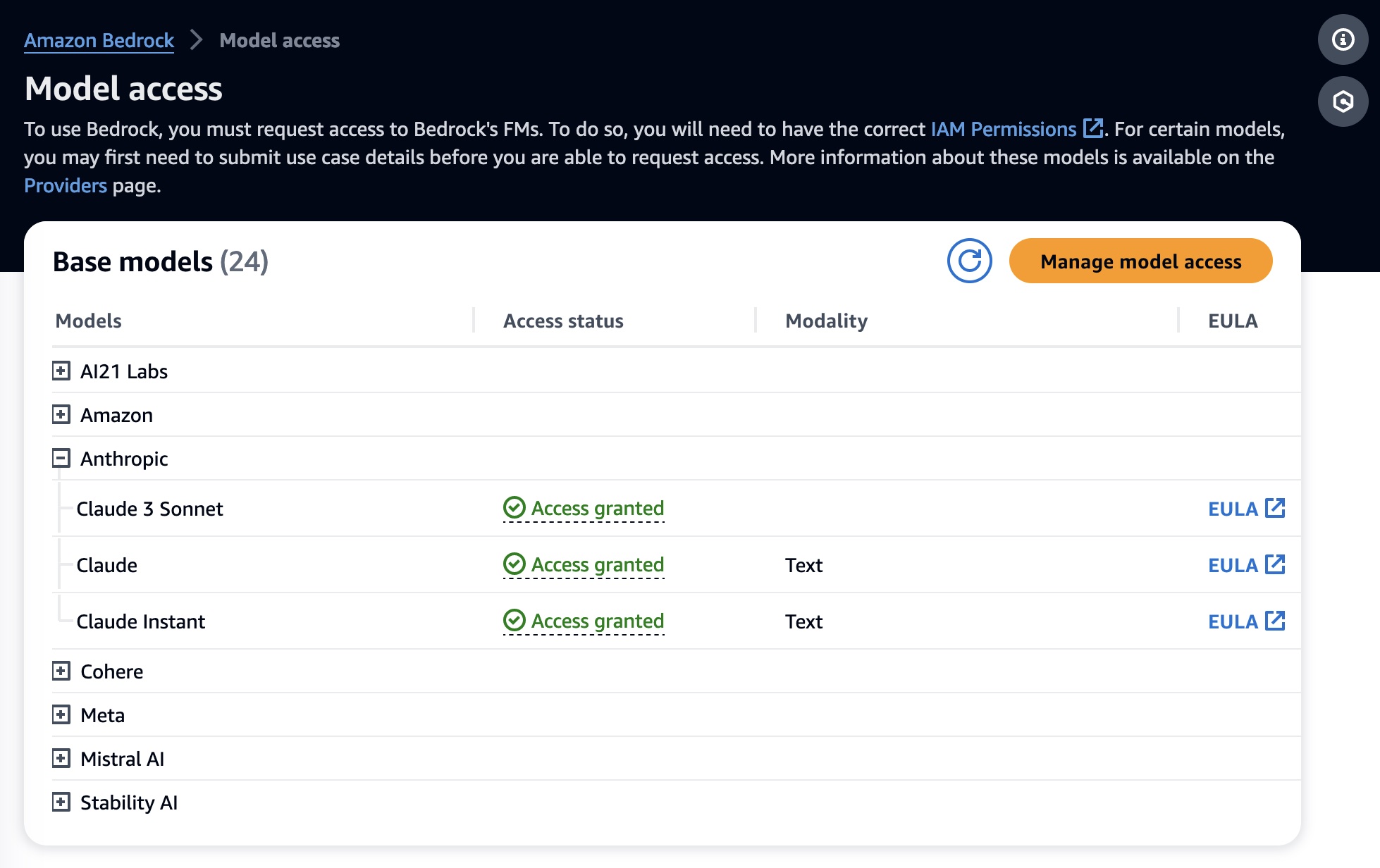
To test Claude 3 Sonnet in the console, choose Text or Chat under Playgrounds in the left menu pane. Then choose Select model and select Anthropic as the category and Claude 3 Sonnet as the model.
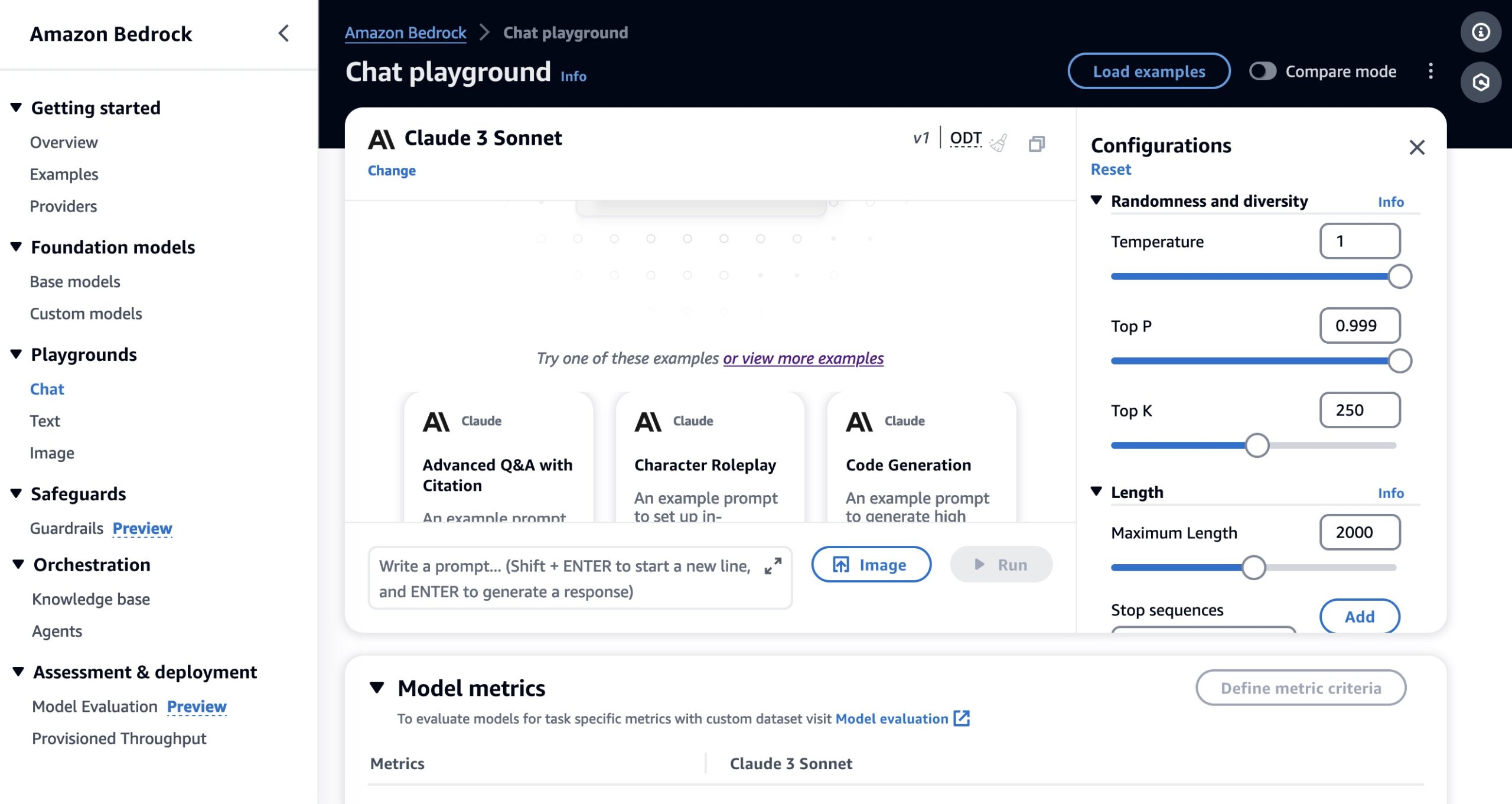
To test more Claude prompt examples, choose Load examples. You can view and run Claude 3 specific examples, such as advanced Q&A with citations, crafting a design brief, and non-English content generation.
By choosing View API request, you can also access the model via code examples in the AWS Command Line Interface (AWS CLI) and AWS SDKs. Here is a sample of the AWS CLI command:
aws bedrock-runtime invoke-model
--model-id anthropic.claude-3-sonnet-v1:0
--body "{"prompt":"Write the test case for uploading the image to Amazon S3 bucketnHere are some test cases for uploading an image to an Amazon S3 bucket:nn1. **Successful Upload Test Case**:n - Test Data:n - Valid image file (e.g., .jpg, .png, .gif)n - Correct S3 bucket namen - Correct AWS credentials (access key and secret access key)n - Steps:n 1. Initialize the AWS S3 client with the correct credentials.n 2. Open the image file.n 3. Upload the image file to the specified S3 bucket.n 4. Verify that the upload was successful.n - Expected Result: The image should be successfully uploaded to the S3 bucket.nn2. **Invalid File Type Test Case**:n - Test Data:n - Invalid file type (e.g., .txt, .pdf, .docx)n - Correct S3 bucket namen - Correct AWS credentialsn - Steps:n 1. Initialize the AWS S3 client with the correct credentials.n 2. Open the invalid file type.n 3. Attempt to upload the file to the specified S3 bucket.n 4. Verify that an appropriate error or exception is raised.n - Expected Result: The upload should fail with an error or exception indicating an invalid file type.nnThese test cases cover various scenarios, including successful uploads, invalid file types, invalid bucket names, invalid AWS credentials, large file uploads, and concurrent uploads. By executing these test cases, you can ensure the reliability and robustness of your image upload functionality to Amazon S3.","max_tokens_to_sample":2000,"temperature":1,"top_k":250,"top_p":0.999,"stop_sequences":["nnHuman:"],"anthropic_version":"bedrock-2023-05-31"}"
--cli-binary-format raw-in-base64-out
--region us-east-1
invoke-model-output.txtUpload your image if you want to test image-to-text vision capabilities. I uploaded the featured image of this blog post and received a detailed description of this image.
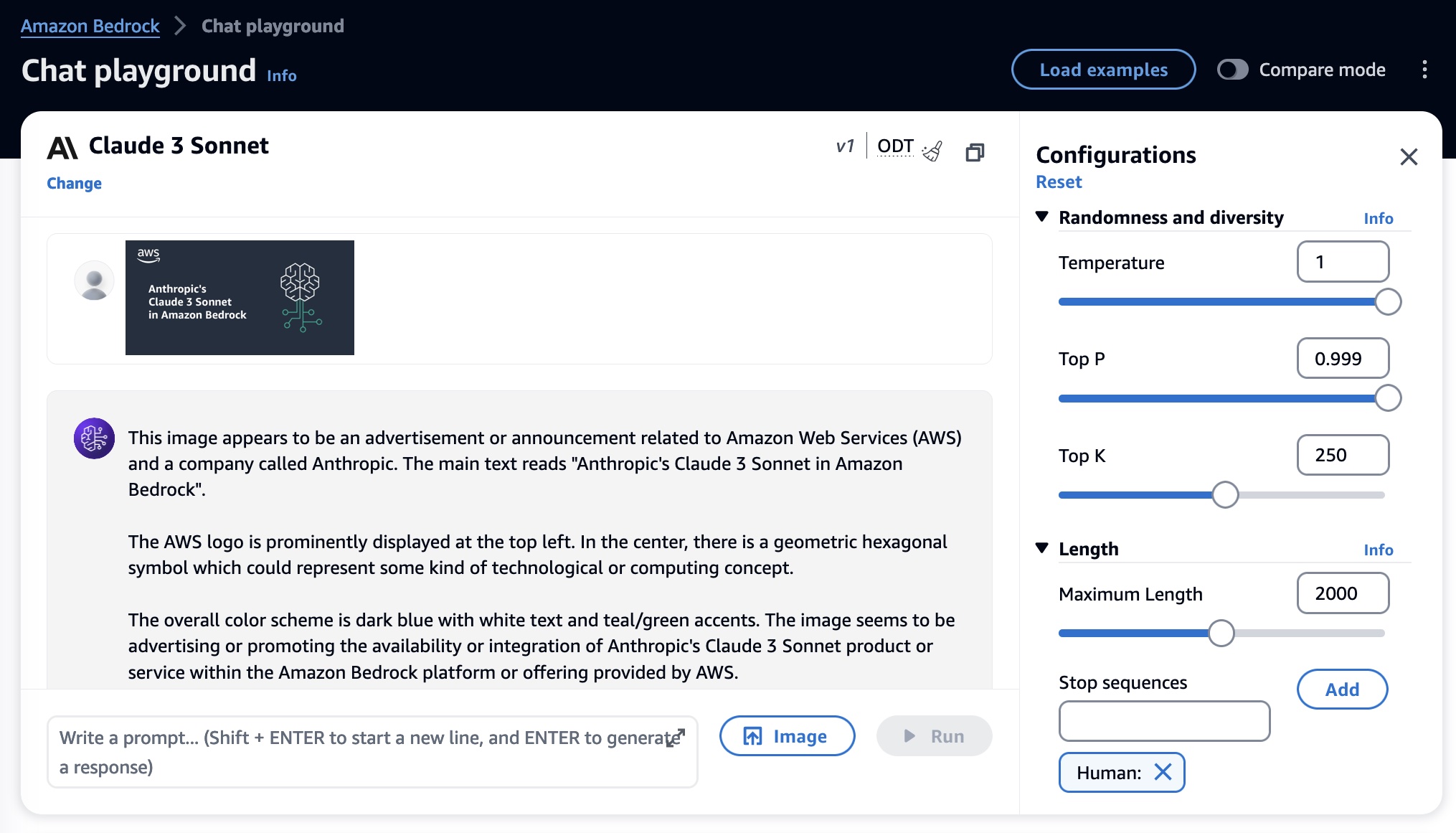
You can process images via API and return text outputs in English and multiple other languages.
{
"modelId": "anthropic.claude-3-sonnet-v1:0",
"contentType": "application/json",
"accept": "application/json",
"body": {
"anthropic_version": "bedrock-2023-05-31",
"max_tokens": 1000,
"system": "Please respond only in Spanish.",
"messages": {
"role": "user",
"content": [
{
"type": "image",
"source": {
"type": "base64",
"media_type": "image/jpeg",
"data": "iVBORw..."
}
},
{
"type": "text",
"text": "What's in this image?"
}
]
}
}
}To celebrate this launch, Neerav Kingsland, Head of Global Accounts at Anthropic, talks about the power of the Anthropic and AWS partnership.
“Anthropic at its core is a research company that is trying to create the safest large language models in the world, and through Amazon Bedrock we have a change to take that technology, distribute it to users globally, and do this in an extremely safe and data-secure manner.”
Now available
Claude 3 Sonnet is available today in the US East (N. Virginia) and US West (Oregon) Regions; check the full Region list for future updates. The availability of Anthropic’s Claude 3 Opus and Haiku in Amazon Bedrock also will be coming soon.
You will be charged for model inference and customization with the On-Demand and Batch mode, which allows you to use FMs on a pay-as-you-go basis without having to make any time-based term commitments. With the Provisioned Throughput mode, you can purchase model units for a specific base or custom model. To learn more, see Amazon Bedrock Pricing.
Give Anthropic’s Claude 3 Sonnet a try in the Amazon Bedrock console today and send feedback to AWS re:Post for Amazon Bedrock or through your usual AWS Support contacts.
— Channy
Capturing DShield Packets with a LAN Tap [Guest Diary], (Sun, Mar 3rd)
[This is a Guest Diary by Christopher Von Reybyton, an ISC intern as part of the SANS.edu BACS program]
Introduction
During my internship with the Internet Storm Center I ran into an issue of wanting more information than the default logs would give me. I recalled one of the instructors saying "If we don’t have packets it didn’t happen". This inspired me to try to capture the packets hitting my honeypot. Initially I looked for ways to add logging capabilities to the DShield Honeypot [1]. I found very little information and the information I found I wasn’t able to get to work. Then I remembered that I owned a Great Scott Gadgets Throwing Star LAN Tap [2]. The Throwing Star LAN Tap is a passive Ethernet tap set between my router and the honeypot where I capture .pcap files with Wireshark.
Throwing Star LAN Tap
The Throwing Star LAN Tap can be purchased from greatscottgadgets.com and amazon.com. It has two pass-through ethernet adapters labeled J1 and J2. This allows the LAN Tap to sit between the router and an end device. There are two other ethernet adapters labeled J3 and J4. These adapters have capacitors connected to them and any packets are output to these monitoring ports. By connecting a device to these monitoring ports we are able to capture packets with apps such as Wireshark or tcpdump.
The following image is how the LAN Tap arrives unassembled.
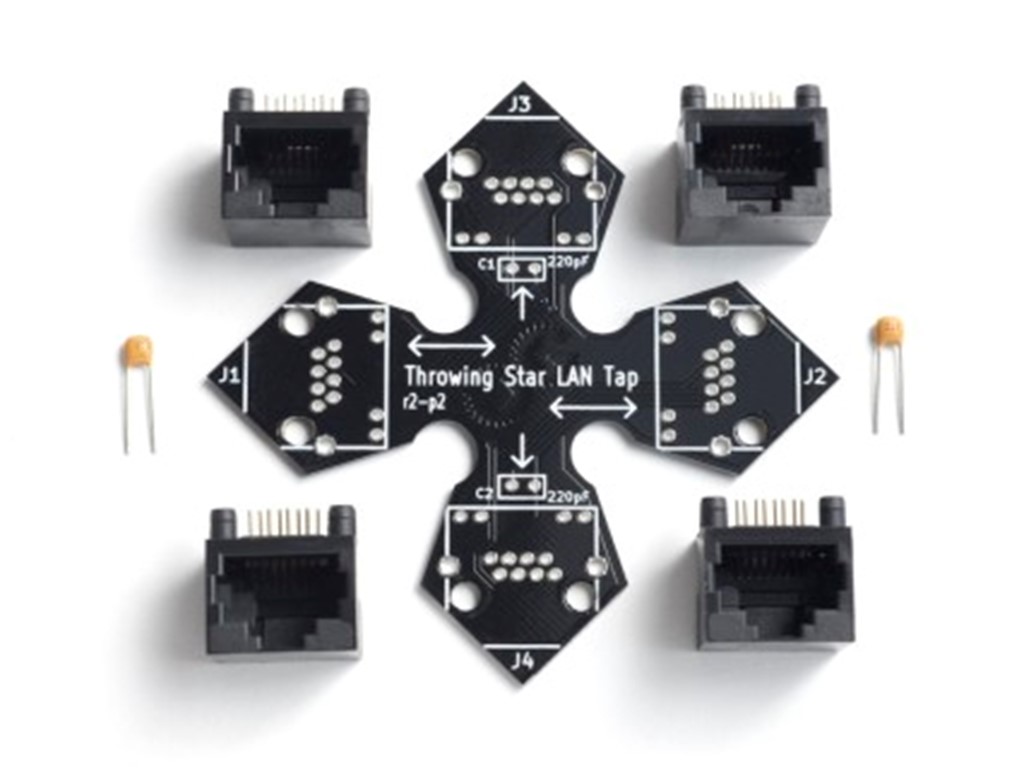
Next is how the LAN Tap looks when assembled. Notice the placement of the capacitors.
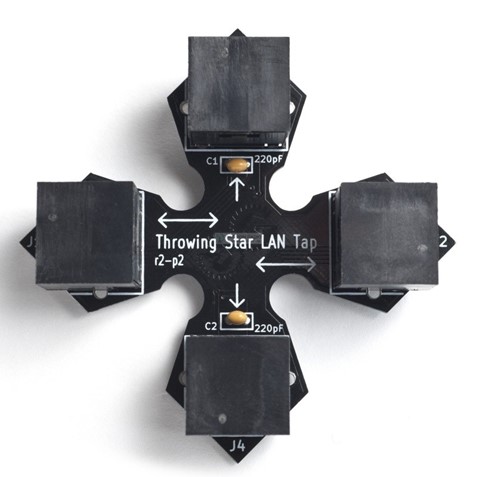
Here is an image of the back of the LAN Tap after soldering.
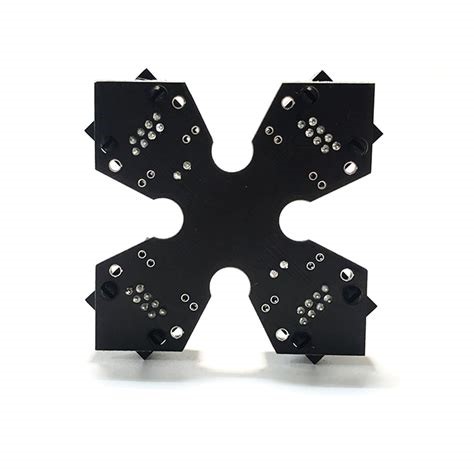
Lastly here is a graphic showing the direction the packets travel to the monitoring ports.
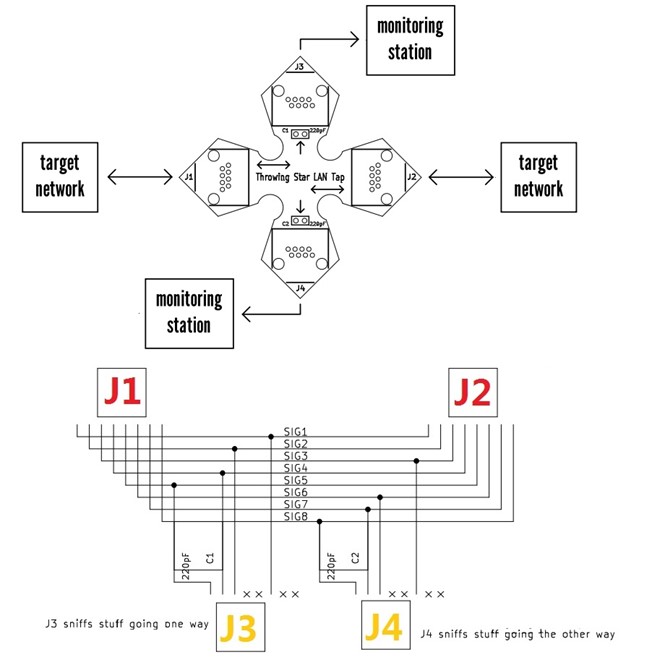
Analysis
An example of how the packet information from Wireshark helps in attack observations can be found in the following screenshots.
First is output from the honeypot using the command "cat webhoneypot-2024-01-25.json | jq 'select(.sip == "80.94.95.226")'". This image shows output with a timestamp of 23:43:18. The attacker is trying to POST information to "/cgi-bin/luci"
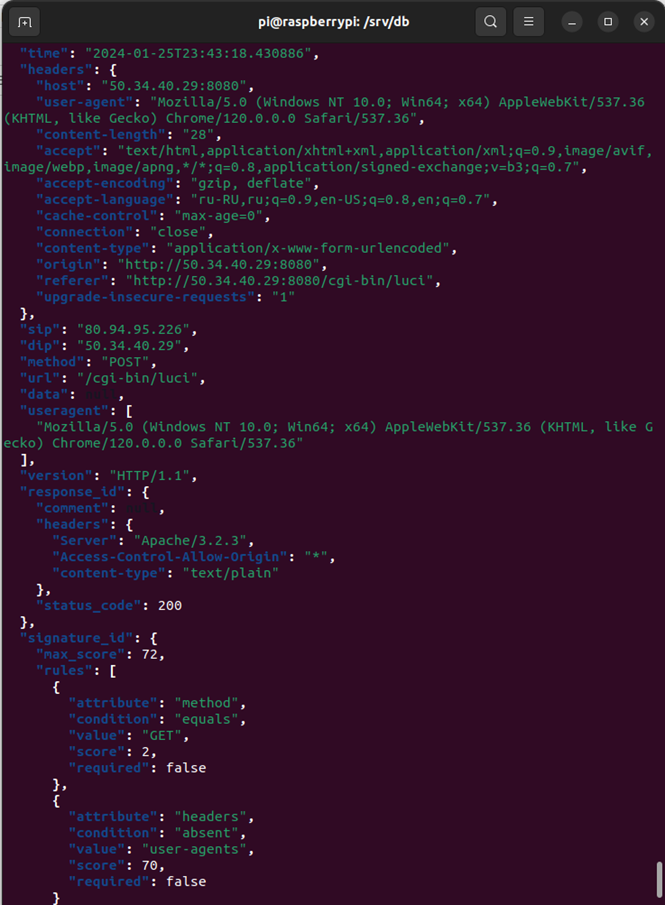
The next screenshot shows the output from Wireshark using the filter "http.request.method == "GET" || http.request.method == "POST". At No. 5181 and timestamp 23:43:17 we see the POST request from IP 80.94.95.226
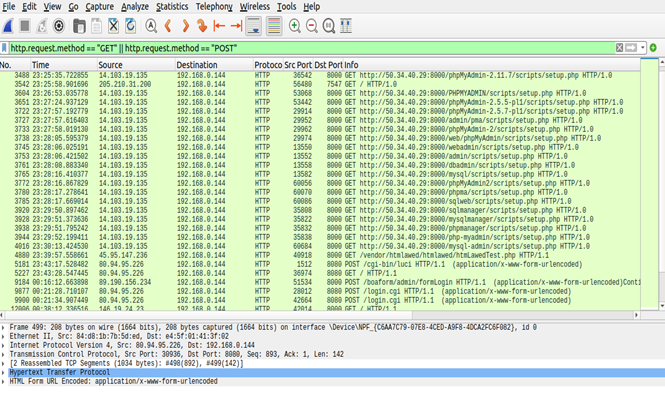
If we then follow the HTTP Stream of this conversation, we end up with the next screenshot. If you look at the end of the output, you will see the username and password used by the threat actor. This is information that is absent in the DShield logs and gives added insight into the attackers’ behavior.
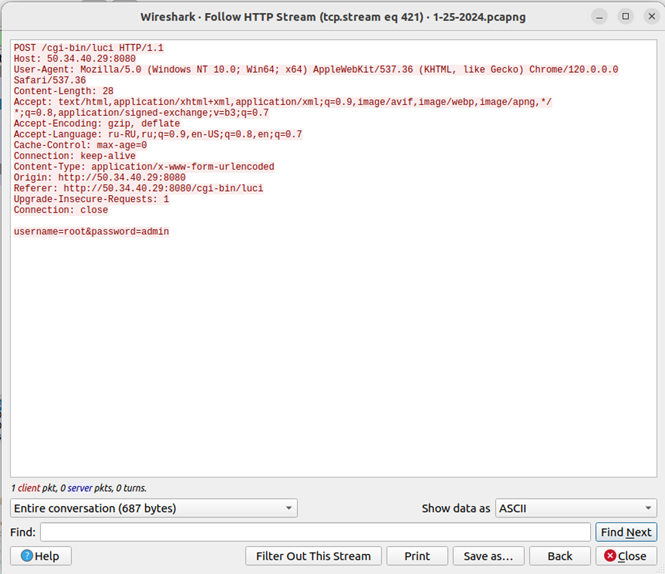
Identified problems
The main problem I ran into was that my Throwing Star LAN Tap was a kit. I had to solder the Ethernet connectors and diodes to the circuit board. As I don’t have a lot of experience with this it took some trial and error to make sure the connections were soldered on correctly. My first attempt after soldering seemed to have worked as I was able to receive packets for many hours. The next day that I connected I only captured packets that came from the honeypot. I had to disconnect the LAN Tap and go over the connections again to make sure the soldering was correct. The third attempt resulted in capturing full packets.
It should be noted that the reason I only captured packets coming from the honeypot on the second day is that since the Dshield honeypot resets every day the LAN Tap needs to be re-connected everyday as well. And that the monitoring ports only monitor traffic in one direction.
Why It Matters
Packets are how everything is communicated through networks. It doesn’t matter what protocol is used or where the device is located. And while collecting logs is important, being able to see the history of the logs communication in the form of packets is the basis for good information security. Information that may be passed in clear text in the packets may not be picked up by DSHield logs.
Benefits
The main benefit of capturing packets is that you have visibility into the communication going to and from the DShield honeypot. It’s nice seeing the SSH and HTTP logs that DShield collects, but being able to go through the packets gives a much deeper insight into what attacks are happening and how they are happening. For me parsing logs felt like only seeing part of the conversation. Being able to see the packets now makes parsing the logs more complete and easier to interpret.
Conclusion
Capturing packets between the DShield honeypot and an externally facing router is a powerful tool to help with attack observations and identifying threat actors’ behavior for accurate documentation. In the future I would love to see packet capture capabilities added to the DShield, but until then using a LAN Tap can give us vital information to increase the scope of our attack documentation.
[1] https://isc.sans.edu/tools/honeypot/
[2] https://greatscottgadgets.com/throwingstar/
[3] https://www.sans.edu/cyber-security-programs/bachelors-degree/
———–
Guy Bruneau IPSS Inc.
My Handler Page
Twitter: GuyBruneau
gbruneau at isc dot sans dot edu
(c) SANS Internet Storm Center. https://isc.sans.edu Creative Commons Attribution-Noncommercial 3.0 United States License.

![[Guest Diary] AWS Deployment Risks – Configuration and Credential File Targeting, (Thu, Mar 7th)](https://www.ironcastle.net/wp-content/uploads/2024/03/status-2.gif)
